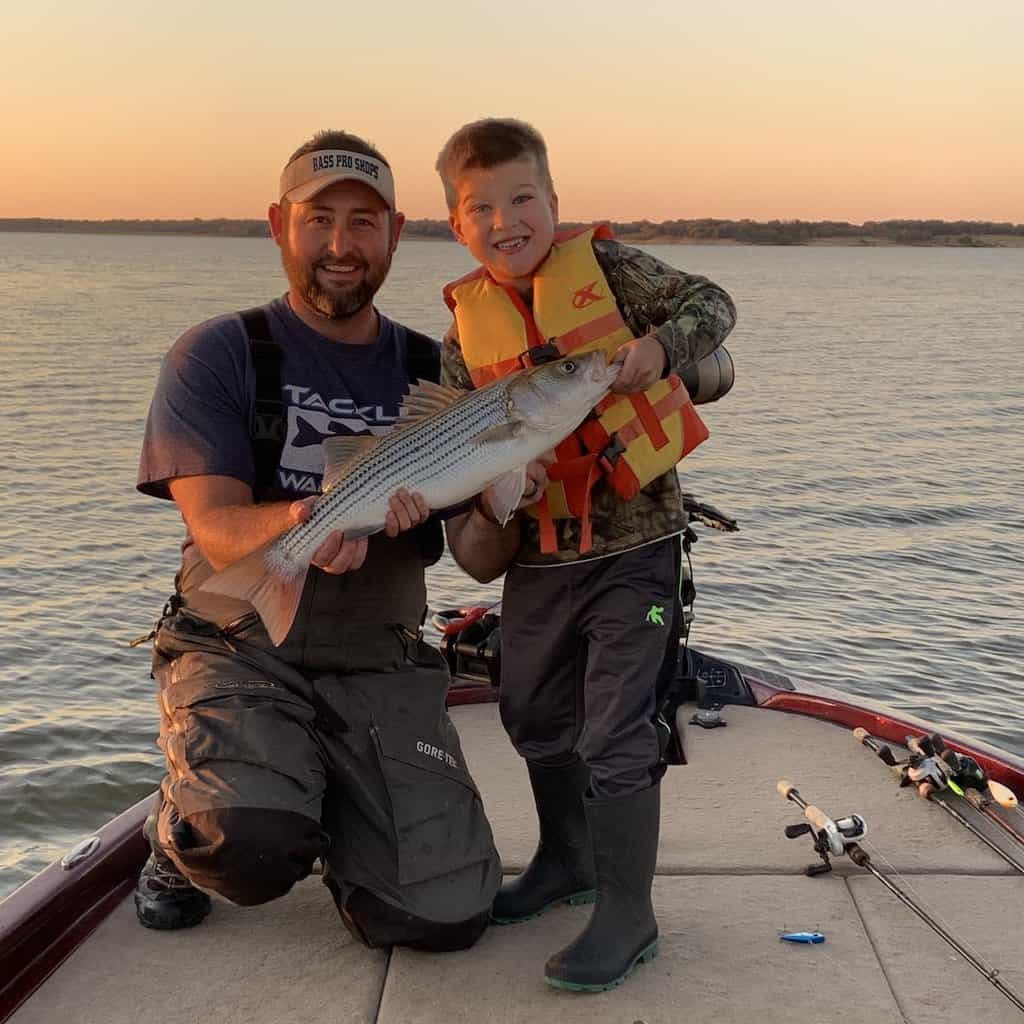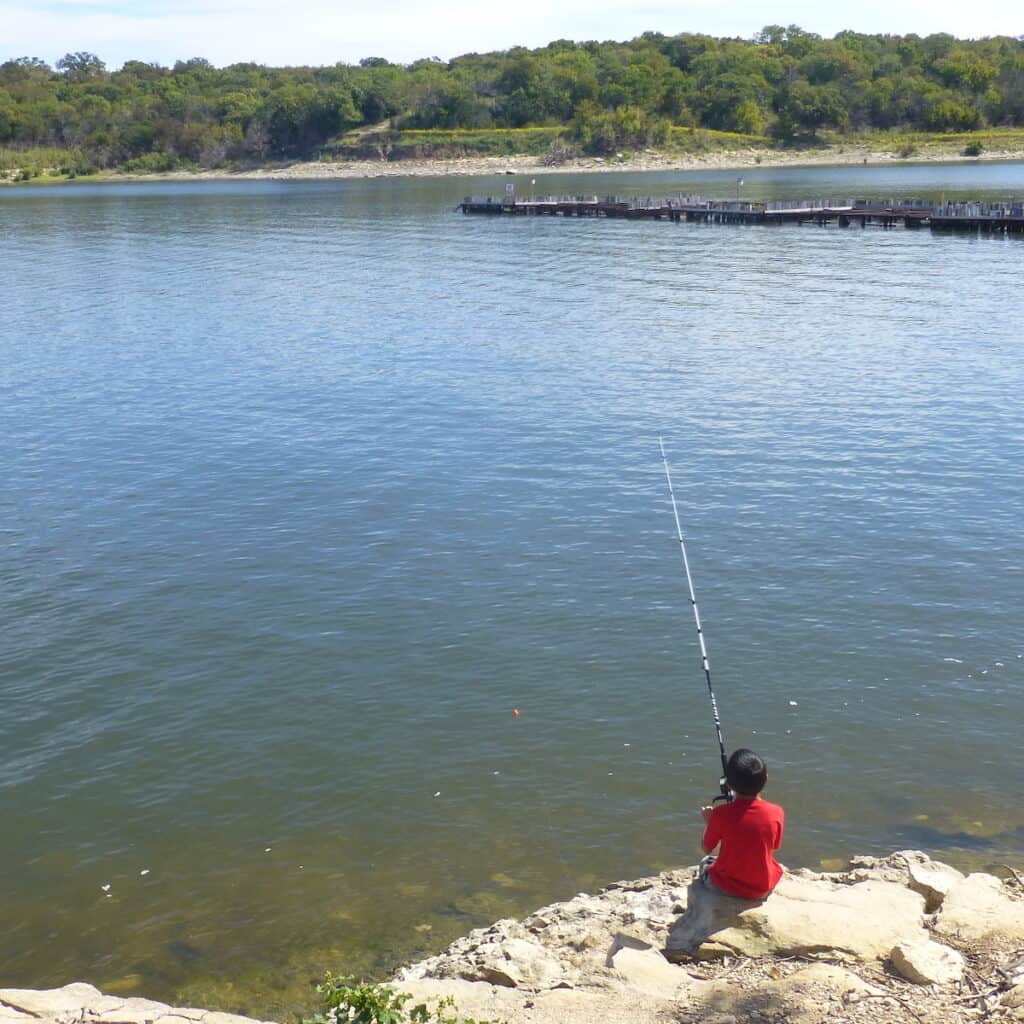Lake Texoma has nearly 600 miles of shoreline encircling 89,000 acres along the border between Texas and Oklahoma, fed by the Red and Washita Rivers and many smaller streams. That’s a whole lot of fishing.
Lake Texoma, one of the largest reservoirs in the United States, is often called “The Striper Capital of the World,” and for good reason.
But there’s also plenty more to fishing Texoma than catching striped bass, including lots of other bass, catfish, panfish and even massive alligator gar.
This complete guide to fishing at Lake Texoma will get you well on your way to catching all of the lake’s most popular game fish species, whether you’re driving up from Dallas, down from Oklahoma City, or coming to this world-famous fishing spot from farther afield.
Lake Texoma Fish Species
Lake Texoma attracts a couple of million anglers each year because it has so many fishing opportunities for just about anyone.
The Oklahoma Wildlife Department (ODWC) and Texas Parks and Wildlife (TPWD) do a tremendous job of managing the lake for the various species, and there are tons of services and amenities for just about everyone.
Lake Texoma Striper Fishing
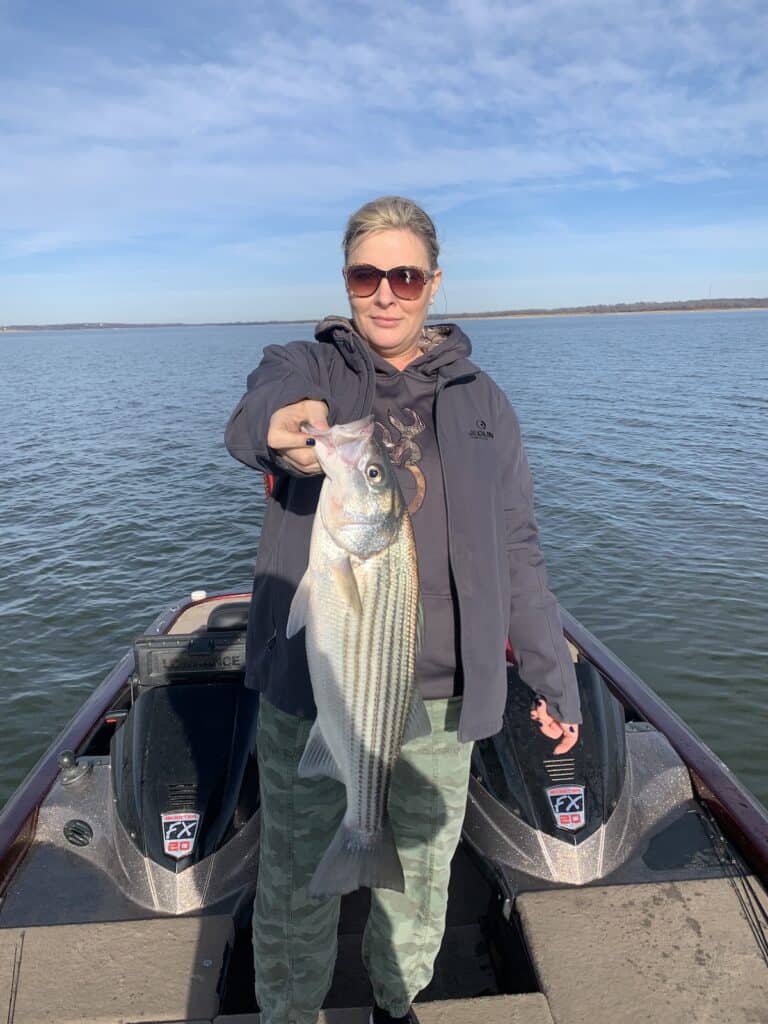
The biggest draw to Lake Texoma is the world-class striped bass fishing, in large part because this big water is full of threadfin shad that stripers gorge themselves on. And it’s also stocked to keep the population strong.
Stripers can grow to impressive sizes and are so fun to catch. The lake record here tops 35 pounds.
Stripers are rarely caught from the shore because they spend most of their time cruising the lake, looking for their next meal. They are pelagic hunters, meaning they search for prey in open water, unlike black bass species that are structure-oriented.
This means you’ll likely need a boat and be able to cover water until you find the fish to have a successful day of striper fishing.
I recommend hiring a professional guide because they have all the equipment and know all the spots, which change frequently as the schools of stripers move around to feed.
Even if you do have your own boat and plan to be fully geared up, hiring a good guide early on can help you cut down your learning curve, making you more likely to catch fish. There are somewhere in the neighborhood of 100 guides working on the lake.
You need strong gear like a heavy-duty bass rod and reel to catch these fish.
Fishing with live bait is one of the most popular and effective methods of catching stripers on Texoma.
Whatever else you do, make sure that your live bait is shad, because stripers will usually take a pass live minnows that other gamefish would gobble up, Oklahoma fishing guide Josh Teply said.
That said, catching stripers on a topwater lure might just be the most fun you’ll ever have fishing. The cigar-shaped Heddon Super Spook is a classic striped bass topwater lure. The Cotton Cordell Pencil Popper and Strike King Mega Dawg will produce similar results.
These topwater lures will really shine when slightly cooler weather returns in the early fall. September can be incredible.
A variety of other artificial lures will catch plenty of stripers when you need to follow them into deeper water, including lipless crankbaits, jigs, spoons, spinnerbaits, swimbaits (including on umbrella rigs) and other types that mimic the shad baitfish. Here’s a list of 20 favorite lures of all types for Lake Texoma striper fishing.
To narrow your search on such a massive lake, know that Platter Flats and Washita Point (on opposite sides of the lower end of the Washita Arm) are excellent striper fishing areas Teply recommends on Texoma.
Some sources also mention hybrid striped bass fishing at Texoma, but in Teply’s experience, these fish are caught few and far between, or less, than their parent species, true stripers and white bass.
However, where hybrid stripers occur, they often fall for similar fishing techniques that work on pure stripers or white bass.
Lake Texoma Bass Fishing
Lake Texoma has three types of black bass commonly found in both states.
Largemouth Bass Fishing
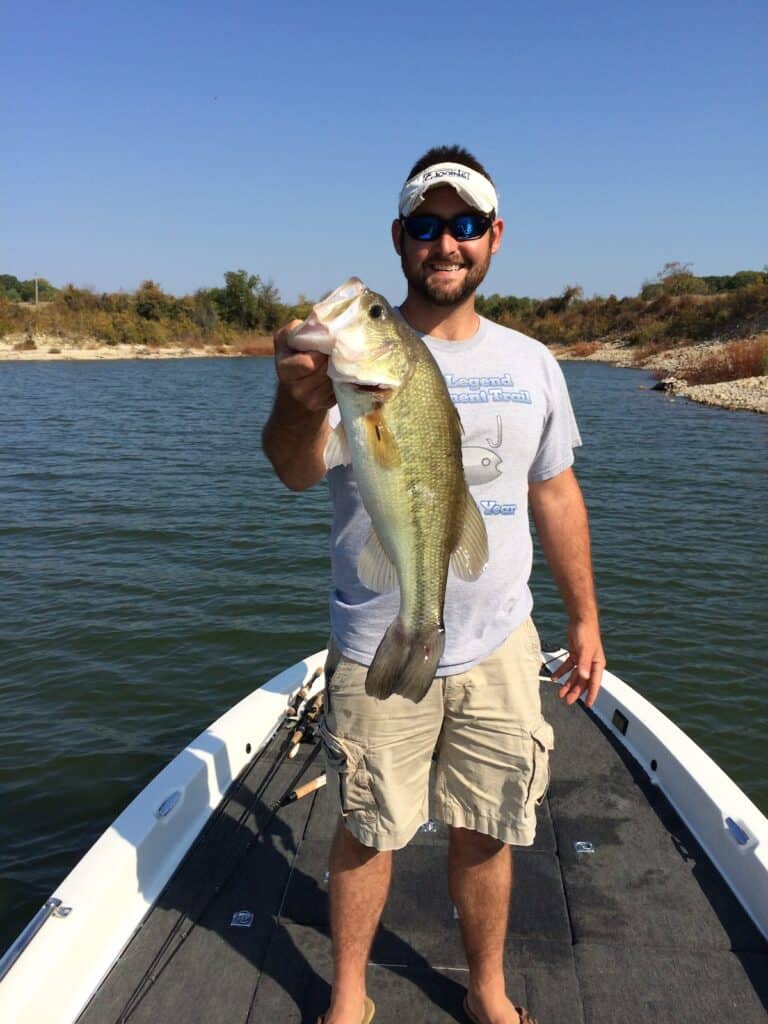
It’s a rare lake in Texas and Oklahoma that doesn’t have largemouth bass at the top of one of our fishing guides. But don’t let that fool you for Lake Texoma.
The largemouth bass in the reservoir are the big draw for bass fishing tournaments. State fishery agencies have been stocking Florida strain largemouth in the lake, although they are still fairly rare at this writing.
Largemouth bass fishing on Texoma will be like most other Oklahoma and Texas lakes, so bring a variety of your favorite bass lures and techniques.
As with most big waters, boat anglers are more successful here because they have access to the most productive areas. Begin in the creeks with cover or a flat near a drop-off.
There are docks along the lake that largemouth love to hang around; however, some marinas won’t allow fishing in them, so pay attention to the signs and read the lake’s regulations for Oklahoma and Texas.
If you’re a bank angler, you can still catch bass here. The places to start from shore are at one of the state parks, where there are lots of public bank fishing opportunities.
You’ll find Lake Texoma featured in both our Best Bass Fishing in Texas and Best Bass Fishing in Oklahoma articles.
The extreme ends of the lake are ideal for largemouth fishing at Lake Texoma.
Some specific areas that Teply likes include Big and Little Glasses Creeks on the Washita Arm, the Red River Arm, and Little Mineral Creek on the southwest side of the lake in Texas are excellent places to focus on for largemouth bass fishing, Teply said.
Smallmouth Bass Fishing
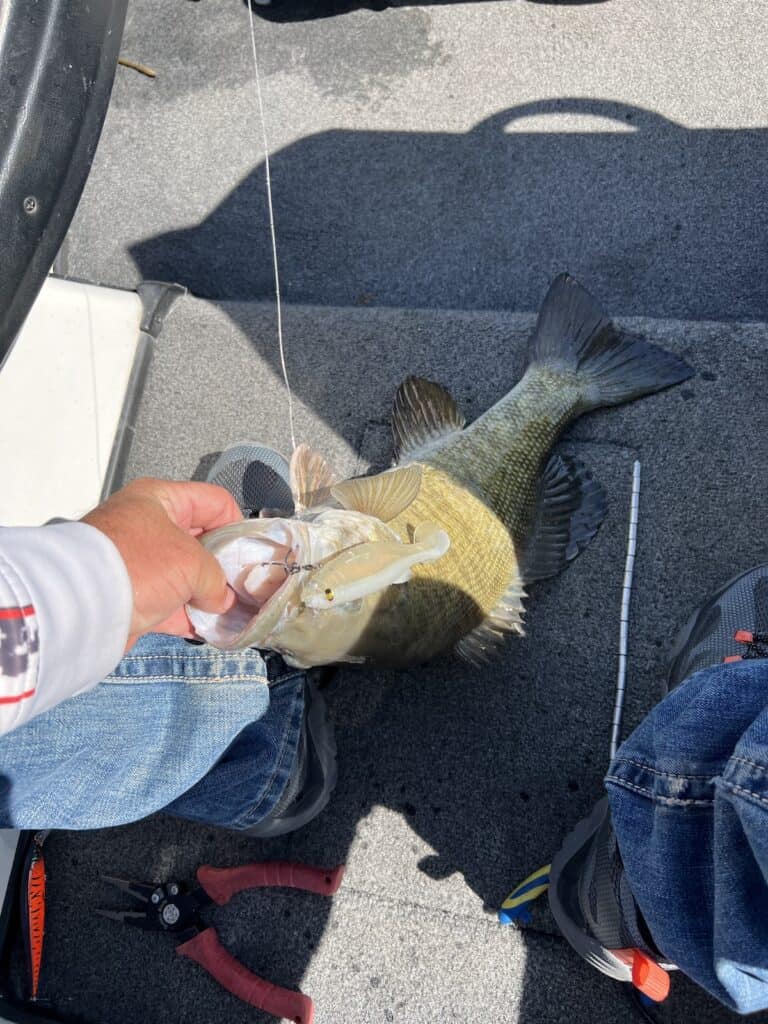
Smallmouth are another draw for many bass anglers. Even though they don’t get as big as largemouth, they fight much harder pound for pound and are just as enjoyable to catch, if not more.
Their population has been increasing noticeably in recent years.
“And there’s some big ones in that lake, a lot of 5-pound-plus smallmouth in that lake,” Teply said.
Smallmouth bass act differently than largemouth. They tend to stay deeper offshore and congregate most often around rock piles, although they will be around other structures as well.
Again, a boat will be a big advantage in finding the best holding spots while chasing these bronze bass.
Like other bass, they will come into shallower water each spring to spawn, so that’s the best time to reach them if you’re on shore.
Downsizing lures will yield the best results because it’s difficult to hook a smallmouth bass with big baits often used for largemouths.
Soft plastic rigs like a Ned rig, drop-shot, or shakey head work well for smallies. Jigs, crankbaits, and other lures that look like a crawdad or small fish also will fool these aggressive fish.
My favorite lure to throw in the late spring and early summer is a Mepps spinner or Rooster Tail. Smallmouth will hammer it, and it doesn’t require skill to throw.
Smallmouth fisheries are somewhat limited elsewhere in Oklahoma, but you can find all the best smallmouth fishing spots in Texas in our complete guide.
In general, Lake Texoma smallmouth bass fishing is best closest to Denison Dam (Lake Texoma Dam). Grandpappy Point, in Texas on the southeastern shore, is a great place to start for smallmouths, Teply said.
Spotted Bass Fishing
Easily misidentified as largemouth bass, Alabama spotted bass don’t grow as big. The best way to tell them apart is how the eye and mouth hinge line up. A spotted bass’s mouth hinge lines up vertically with the back edge of the eye, while the largemouth’s big mouth extends behind the eye.
Spotted bass prefer clear water. They can be found in clear creeks and streams entering the lake and in deep rocky areas. If it’s a muddy bottom and dirty water, it’s unlikely you’ll catch spotted bass.
Lures that imitate crayfish, insects and bluegill will offer you the best chance of catching a spotted bass in Lake Texoma.
Catch More Bass
Find a bunch of lure ideas, rigging suggestions and more tips and techniques in our easy bass fishing how-to guide. These tactics will work for largemouth, smallmouth and spotted bass alike.
White Bass Fishing
White bass are extremely abundant in Texoma.
A boat will greatly increase your catch rates of white bass for much of the year, especially during the hotter and colder months.
However, you can easily catch white bass during the spawn as they move into the tributary creeks and rivers from the banks at public access areas in the spring. Jigs, small spinners and lipless crankbaits work well during the spawn.
During the heat of summer, these fish will go deeper and often out of casting range from shore. Your best bet from a boat is to troll using spoons and lipless crankbaits along the creek and river channels at this time of year.
If you find a big school of baitfish, the white bass and hybrids will be close, especially if it’s in the middle of the lake.
Like their cousins, the striped bass, the smaller sand bass (as well as hybrid stripers) are a schooling fish and patrol the waters they inhabit. They rarely use cover or structure like brush piles and rock piles along the shore.
You’re more likely to find them along the creek and river channels with a flat nearby because they’ll feed along the flat and then move back to the deeper water of the channel.
Head into the main rivers in the spring once the water temp hits about 54 degrees.
Any of the main feeder rivers, the biggest being the Washita and Red Rivers, will be big draws for white bass.
In fact, the smaller tributaries off those main rivers are especially good at concentrating large numbers of easy-to-catch white bass, Teply said.
As just one example, Hickory Creek and a few other creeks near Lebanon on the Red River Arm absolutely fill with white bass during the spring spawn.
Lake Texoma Catfish Fishing
If catfishing is more your speed, Lake Texoma won’t disappoint. There are plenty of channel catfish and blue catfish to be found here, as well as a smaller number of potentially huge flathead catfish.
You’ll likely catch channels and blues out of the same hole using much the same bait.
The great thing about catfishing is that you can do it from the bank and have great success, or hire a guide to teach you the ropes if you want some expert instruction.
Catching blue catfish requires a strong rod, reel, and line. These fish can be massive. The Texas state record of over 121 pounds was caught here, as was the Oklahoma state record of 98 pounds.
Using a Carolina rig with cut bait is one of the most common techniques, both for blues and channels. Odds are you won’t catch a hundred-pounder, and you’ll likely catch a mixed bag of both species. The best eating catfish are typically under 10 pounds and, better yet, in the 2-5 pound range.
Catfish spawn along sunken roadbeds and rocky areas during the late spring and early summer. This is a great time to catch them from the bank because they’re shallow and aggressive.
The rest of the year, they’ll use creek and river channels as fish highways to move locations and feed along the nearby flats.
Flathead catfish are not as abundant at Lake Texoma as blues and channels. So they’re one of the most prized fish for catfish anglers to catch.
Flathead fishing is very similar to blue catfishing in terms of needing exceptionally strong gear. For flatheads, live bait works better than dead cut fish baits, but fresh cut baits may also entice one. If you really want to give them what they want, a live bluegill is one of the most popular flathead-catching baits.
They have similar patterns to other catfish species, so you won’t have to do anything out of the ordinary to catch them—more than likely, you’ll luck into one while fishing for blues and channels.
Some adventurous locals hand-fish or “noodle” for flatheads. This is where you trap a catfish in its nesting area amongst the rocks and entice the flathead to bite your hand so that you can pull it to the surface. Injuries can occur, especially if what you trap turns out to be a snapping turtle that bites off a finger.
Yes, I’ve been one of those crazy people, but I prefer catching them on a rod and reel.
Lake Texoma Crappie Fishing
Arguably the best-tasting fish around, crappie are beloved by many anglers at Lake Texoma.
During the spring spawn, crappie move shallow and are easy to catch from the bank. However, as summer takes over, they move to deeper cover in search of cooler water and safety, so a boat will probably be needed to locate the schooling fish.
Using ultralight gear for crappie is best. I use a four-pound test line, so they’re less likely to see it. Small jigs and spinners work well at enticing crappie to bite, and live minnows are always good as permitted.
Crappie hot spots will vary in depth day to day with weather conditions, ranging from 1-30 feet deep. Your best bet will be to find a brush pile near a creek or river channel.
Both black and white crappie can be caught at Lake Texoma.
Bluegill Fishing
Bluegill are found all over the lake, but primarily along the shore. These easy to catch fish are a favorite of kids and beginner anglers.
They’ll hit live worms and other baits, plus artificial lures including small jigs, spinners, flies and poppers.
If you’re around a dock, brush pile, or grassy area, chances are there’s are bluegill there. They stay shallow during the late spring and early summer, typically five feet or less.
If you plan on keeping them to eat, make sure they’re at least the size of your hand; otherwise, there’s not enough meat on the fish. They also make excellent live bait for other fish species like catfish and bass.
Alligator Gar
Not as many anglers target alligator gar, maybe because they’re so challenging fish to clean and they require special gear to catch.
Lake Texoma and especially in the Red River above or below it are some of the few places you can catch alligator gar in Oklahoma, with a few more gar fishing spots available in Texas.
Bowfishing is one of the most popular ways of catching these ferocious-looking fish, which have mouths full of sharp teeth. Another way is similar to catfishing, except you use a few hooks or a wad of fishing line.
Stick the bait in the middle of the ball of fishing line, and when they bite it, the line will get tangled in their teeth, allowing you to battle the gar and reel it in.
Gar are a patrolling predator fish, so they can be caught from the bank, especially if you’re fishing along a creek. Try finding a deep hole where big fish are more likely to spend their time.
Texoma Lake Fishing Tips
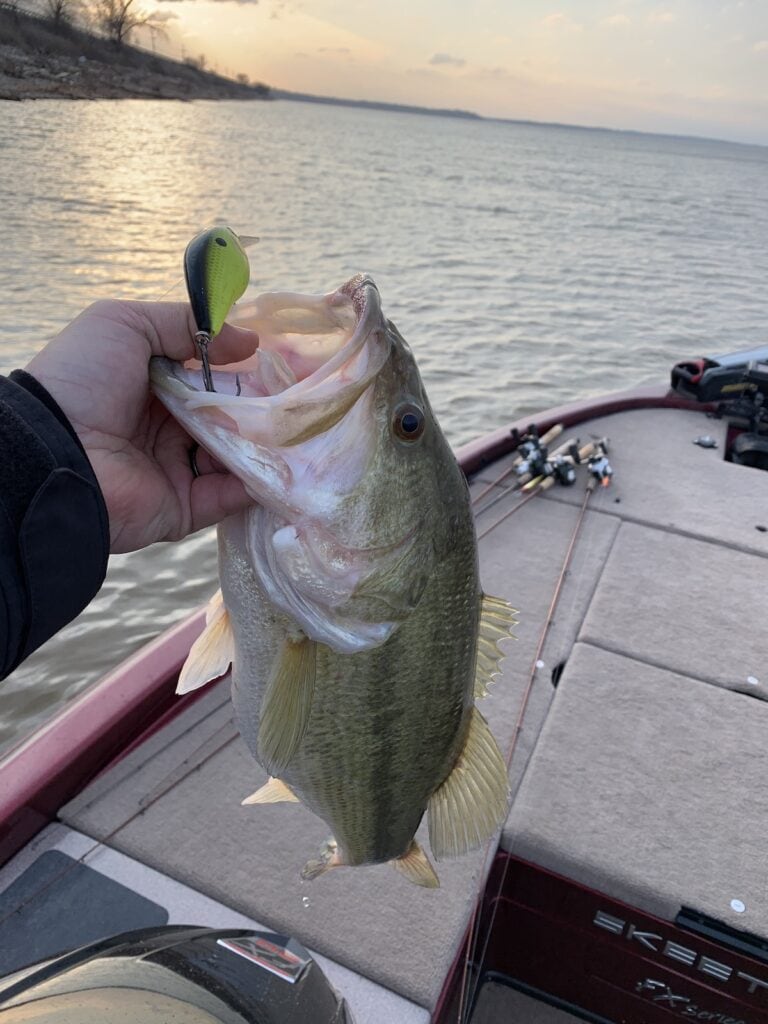
Lake Texoma is a massive lake, so it’s best to break it into smaller segments and focus on a specific area. The following tips are general rules to keep in mind when fishing; of course, there’s always an exception to the rule, so keep an open mind.
When to Fish
Nights and early mornings tend to be best during the hottest times of the year. If you’re fishing during the late fall and winter, it’s often best to wait until the water temperature has warmed up a bit, so the fish are most active.
Checking solunar and barometric pressure tables for the best fishing times is also wise. Although they don’t determine if I’ll go fishing, they help me keep my expectations in check.
Lake Texoma Fishing Spots
Finding a place to fish is one of the most significant factors that will determine your success. If you’re fishing in a spot the fish aren’t, you’re not going to catch anything.
One of the biggest factors determining where fish will be is the time of year. During the spring and early summer, many species of fish are spawning and will generally be more shallow. As the water heats up, they move deeper in search of cooler, more oxygenated water.
During the early fall, they move shallow again to feed up before winter sets in, where they’ll move back offshore to deeper water.
The best spots are often along drop-offs and channels. This is because many fish use these as a travel corridor.
Finding structures like brush and rock piles are other areas many of these game fish congregate because the baitfish feel safe, and the big fish follow them to the site and use the structure as a hiding spot to ambush their prey.
Many predator species also will feed on baitfish on shallow flats near a drop-off.
Tips & Tactics
Tips and tactics will vary depending on the species you’re targeting. My best advice is to ask other anglers or fishing-focused business people what they’re doing and how well it’s working. Most people are willing to help you out if you’re polite.
Starting at one of the bridges that cross the lake is one of the best ways to quickly find fish.
Lake Texoma Fishing License
Texas and Oklahoma offer a special Lake Texoma License.
With this license, residents of either state can fish any waters of Lake Texoma, even without their respective state’s fishing license.
The licenses are good through the end of December of each calendar year regardless of when you buy it.
At last check, the annual fee for a Lake Tacoma License was $12.
See the Texas Parks & Wildlife or Oklahoma Department of Wildlife Conservation for details and updates.
Planning Your Trip
Visiting Lake Texoma can be a fun adventure for the entire family, as long as you properly plan.
Getting to Lake Texoma
There are several ways to get to Texoma from either side of the Oklahoma/Texas border.
From Oklahoma, the primary way is to use I-35 and exit onto Highway 32, which will eventually transition into Highway 70 before you get to Durant. Or you can turn south onto Highway 377, which crosses the lake before heading into Texas.
Figure a bit over a 2-hour drive from Oklahoma City to Lake Texoma State Park located on the Washita arm of the lake that juts north into Oklahoma, for example.
From Texas, use I-35 to get to the western side of the reservoir or Highway 75 to get to the eastern end near Denison Dam. Eisenhower State Park near the dam is a bit over an hour from Dallas.
A variety of other highways will take you to different sections of the lake, so plan to use Google Maps or another app for exact directions.
Bank Access
There are several state parks and public areas in both states around the lake that offer bank access for fishing. This lake is a U.S. Army Corps of Engineers lake, but not all banks are suitable for fishing.
Boat Access
The state parks and many public areas also have boat ramps, and some marinas have boats available for rent. If you have your own boat, bring it so you’re guaranteed one.
Camping & Accommodations
RV and tent camping can be found at the state parks, and there are many hotels in the town surrounding the lake, especially along the I-35.
Lake Texoma State Park is one of Oklahoma’s most popular state parks. Eisenhower State Park is the most popular state park on the Texas side of Lake Texoma.
Acknowledgment
Thanks to Josh Teply Fishing for providing expert tips for this article.

